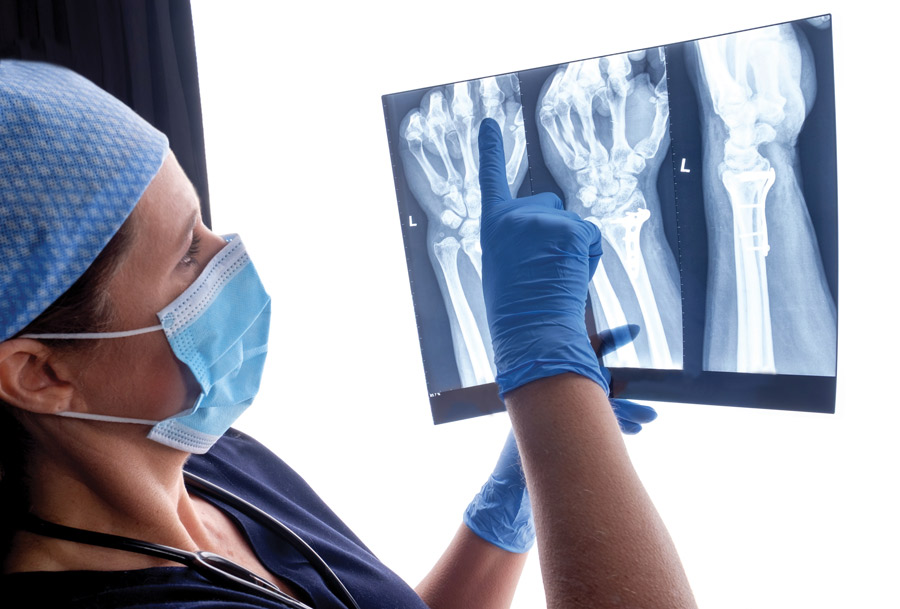All hand and wrist fractures could potentially require surgical management. “It depends on the characteristics of the fracture,” says Dr. Julka, who says distal radius, scaphoid, metacarpal and phalanx fractures are very commonly
treated with surgery in outpatient settings. “Fractures that are minimally displaced, with no malrotation and devoid of significant anatomic abnormality can usually be treated in a cast,” he says.
The length of procedures varies, depending on the type of fracture and complexity of the surgery. “Simple scaphoid and other small fractures can last 15 to 20 minutes,” says Dr. Julka. “Complicated wrist fractures that are
safe to do in the outpatient setting can take two or three hours.”
• Equipment and instrumentation. Dr. Julka says hand and wrist fractures require a mini C-arm for X-rays because they emit less radiation, are more maneuverable and are more cost-effective than larger fixed-based models. Much of
the instrumentation can be kept at the surgery center under a consignment agreement, which allows ease of access to the equipment for the surgeon. He additionally uses his surgery center’s general soft-tissue hand and fracture trays.
A vendor representative is usually on hand at Dr. Julka’s facility. “They maintain the inventory for the instrumentation and document what we use so they can charge the surgery center,” he says. “They also usually act
as another set of helping hands. They’re not scrubbed in, but they’re on the sidelines. If a scrub tech assisting with the surgery is unfamiliar with the equipment, they’ll help with that. If something’s missing,
they’ll find an answer. If another set is needed, they’ll track it down.”
• Anesthesia techniques. Dr. Julka says the vast majority of his hand and wrist fracture repairs are done with the patient sedated and regional anesthesia placed near the shoulder to block all the nerves. “It essentially
makes the arm completely numb,” he says. “There’s no motor or sensory function, and the patient is unaware of the surgery.”
Dr. Julka also frequently employs local anesthesia at the surgical site. In these cases, sometimes the patient is mildly sedated; other times, the patient is awake. “With patients who are elderly or have poor reactions to sedation anesthesia,
I get them completely numb and do the fracture repair while they’re awake and chatting with me,” he says. “Then they go home without having had any sedation, anesthesia or narcotics.”
Robin Kamal, MD, MBA, a hand and upper extremity surgeon who is medical director of the orthopedic service line at Stanford Health Care in Palo Alto, Calif., uses regional anesthesia for challenging larger procedures that involve bony work
in the forearm, elbow or arm, and local anesthesia for smaller, more localized procedures.
Patients who receive local anesthesia and remain awake during procedures can go home 15 to 20 minutes after surgery, according to Dr. Julka.
Cases involving regional anesthesia also call for timely discharges because there’s no need to intubate or extubate patients. “We don’t need to worry about them getting nauseous or waking up from surgery, and their recovery
is about 30 minutes,” he says.
Dr. Julka and his team employ multimodal pain control methods that vary depending on the nature of the fracture and the procedure. “Regional anesthesia allows patients to have a numb arm with absolutely no pain for 12 to 16 hours, which
is the most painful portion of postoperative recovery,” he says. “Once their arm wakes up, they’re in much less pain.”
As a result, he prescribes acetaminophen and naproxen, with a small one- or two-day script for narcotics, usually oxycodone. Prior to surgery, his anesthesiologists occasionally give patients IV acetaminophen and the nerve pain medication
gabapentin.
Pain, or the relative lack thereof, often depends on not just the surgery type and method used, but also how well the surgery is actually performed, he says. “If it’s done skillfully with minimal bleeding and with minimal trauma
to the soft tissue, patients experience far less pain,” says Dr. Julka. “If a surgery that could be done well in 30 minutes takes two hours because the surgeon or staff are inexperienced, it will likely result in more pain
for the patient.”
Dr. Kamal and his care team focus on pain control methods before and after surgery, and are sure to elevate the hand to prevent swelling, which can cause complications and pain. “We’ve shifted our pain regimens for the most part
away from opioids, especially when doing small soft-tissue hand surgery, to multimodal pain management strategies that have been studied and supported in the literature without having the complications of opioids,” says Dr. Kamal.
“We administer a lot with anti-inflammatories, [acetaminophen] and sometimes numbing medications around the incision site.”
• Follow-up care. Dr. Julka says most of his patients get a wound dressing and a splint that they wear from five to 14 days post-op, depending on the surgeon and the fracture. “Typically, their only wound care task is to
not get the splint wet,” he says. “They also need to remember to not do activities involving lifting, pushing and pulling.”
.svg?sfvrsn=be606e78_3)


.svg?sfvrsn=56b2f850_5)